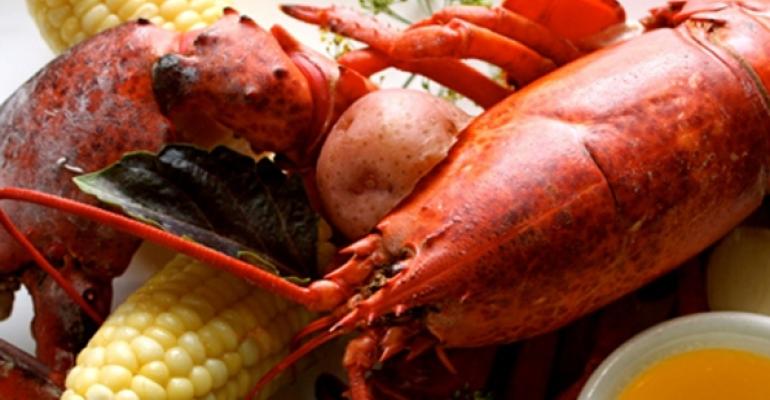While food prices are on the rise virtually across the board in the United States, warmer-than-usual weather has led to an influx of lobsters that has driven prices for the crustaceans to steep lows.
RELATED
• Lobster rolls trending in restaurants
• Chef brings crab house experience to New York
• More restaurant industry food and beverage news
Lobster’s low price is a bit of a fluke: Last May, warm weather off the coast of Maine caused lobsters to start their summertime ritual of molting, mating and coming to shore to feed two months early, according to Bill Adler, executive director of the Massachusetts Lobsterman’s Association.
The lobster traps were filled before Canadian processors were ready for them, resulting in a glut of supply that has driven prices in Maine to about half of what they usually are at this time of year. The asking price is well below lobstermen’s $4-per-pound break even point, Adler said.
With all of that affordable lobster, Nation’s Restaurant News asked a group of chefs for advice on preparing and selling lobster.
How to cool a lobster tail
Kevin Sbraga, winner of Top Chef season seven and chef-owner of Sbraga restaurant in Philadelphia, warns against cooling down lobster tails too quickly.
He serves a buttermilk-battered “country fried lobster” in his restaurant, for which he blanches the lobster and then cools it on ice.

“When you completely shock it in ice, it gets waterlogged, and all the proteins coagulate and congeal and you get that white gooey stuff on it,” he said.
Although Sbraga said that goo is good for adding a lobstery finish to sauces, he doesn’t want it on his lobster tail.
Instead, after blanching a one-pound lobster for about a minute and a half, he places it on ice to let it cool more gradually.
Then he dips it in seasoned flour, then in buttermilk, then back in the flour and deep-fries it for three minutes.
“It’s very popular. And honestly, it’s the most tender lobster you’ll ever have. I’m not sure why, but it’s amazing,” he said.
He sells it for an $18 surcharge to his $49 tasting menu.
Cooking a lobster in a CVAP
Tony Maws, chef-owner of Craigie on Main in Cambridge, Mass., likes to slowly cook the lobster tail separately from the claw and knuckle meat in a controlled-vapor oven.
He first brines the lobster in a simple saltwater solution for a couple of hours, an idea he got from his friend H. Alexander Talbot, author with Aki Kamozawa of Ideas in Food.
“That helps the protein coagulate and separate it from the shell,” he said.
Then he cooks the tails to 50° Centigrade, and the claws to 52° Centigrade.
“Just like chicken breast and thighs cook differently, so do lobster tails and claws,” he said.
He serves the lobster chilled in dishes such as the one offered this week in a $95 farm dinner, with crushed potatoes, cubanelle pepper crema, and what he calls “garden fence leaves” — the lambs quarters, purslane, wild sorrel and other wild herbs that tend to grow at the edge of local gardens.
Marketing lobster dishes
Greg Hardesty, chef of Recess and Room Four, both in Indianapolis, Ind., changes his menu every day, and has recently offered such lobster dishes as a bánh mì lobster roll for $14, as well as more classic preparations.
But the key to his lobster is its marketing.
Hardesty buys lobsters shipped from New England in boxes packed with notes from lobstermen, including maps indicating where exactly the lobsters were caught.
“I shared all that information with the staff, and they can go to the table and hand-sell it that way,” he said.
The lobsters themselves currently cost Hardesty between $16 and $17 each, meaning his sandwiches, which are made with about half a lobster, run at about a 50 percent food cost — and with most of that being the price of shipping them, it’s not likely to come down dramatically.
“On things like lobster, I don’t sell enough of them to make a ton of money, but it keeps people coming back,” he said. “Running a restaurant is a marathon; you can’t make all your money in one night.”
Customers that enjoy the lobster dishes may buy an extra glass of wine, or develop a good relationship with the restaurant and become repeat customers. It is a winning proposition either way, Hardesty said.
“I give them away, basically, and I make up for it on the chicken business,” he said.
Contact Bret Thorn at [email protected].
Follow him on Twitter: @foodwriterdiary





